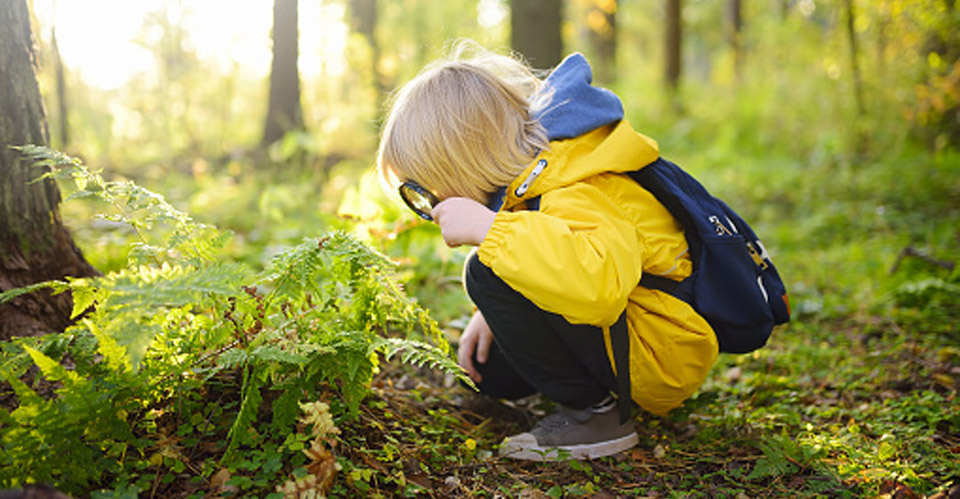
What is Forest School? A Natural Approach to Learning!
Forest School is an approach to learning that takes children into the great outdoors whatever the weather to explore the natural environment.
Generally introduced at nursery or primary school level, Forest School is a long-term, nature-based outdoor learning programme that focuses on holistic development and growth in children.
During regular sessions spread across each of the four seasons, children spend all day outside instead of in the classroom as part of the curriculum, giving them the opportunity to develop a deeper understanding of the world around them.
Being child-led, trained practitioners monitor the children but encourage exploration and discovery and support them to take risks. In a woodland environment. The learning experiences are based on what activities a child wants to engage in at that particular time. Doing this on their own, supervised by a Forest School leader. Here the child builds problem-solving skills, confidence, independence and resilience as they are allowed to test their limits in the natural world.
When did Forest School start in the UK?
Forest School originated in Scandinavia in the 1950s, founded in its open-air culture way of life , which translates into free air life.
The foundations were laid for Forest Schools in the UK in the early 1900s through the Scouts, created by Robert Baden-Powell and Woodcraft Folk, founded by Leslie Paul in 1925.
But it took until the early 1990s, when nursery staff from Bridgewater College in Somerset visited Denmark to study its pre-school system, for it to really take off. Upon their return, they started their own Forest School based on the mainly outdoor, child-centred learning method employed in Denmark.
Since the movement came to the UK, forest school has become increasingly popular as the benefits have become more widely recognised.
Forest School activities and how they benefit children
The hands-on learning approach allows children to develop skills that may be difficult to teach in the classroom. Central to Forest School is to keep active with plenty of activities that enable children to develop motor skills.
Christina Dee of Forest School Learning Initiative has been a Forest School leader for more than 15 years. She has found that children who struggle at being inside unlock their potential when taken outside.
“We have boys who will paint with mud on trees but they won’t pick up a pen or paintbrush inside,” Ms Dee said.
“Forest Schools are an inspirational process where we use the outdoors to learn. I will pick up some sticks and we talk about which stick is heavier and which one is bigger and we use positional language to say where we would put the stick.
Forest Schools And The Curriculum
Many early years settings take children outdoors every now and then, but Forest School is a long-term programme. Children will normally attend these sessions between six to 12 times per year as part of their normal curriculum.
Ideally, the sessions should be spread out over the four seasons, so children can see for themselves how nature changes.
The learning approach ties in well with the curriculum through small achievable tasks that focus on the process rather than the goal.
There is a high staff to child ratio, sometimes even one-to-one, and tasks can be tailored to various subjects, particularly in environmental, science and outdoor education.
Forest School does not necessarily have to take place in a forest. It can be any natural outdoor environment and for some early years settings this can be on the premises or somewhere nearby. For more information visit the Forest School Association
What Forest School Activites include:
- Climbing trees
- Making campfires and cooking
- Woodworking
- Building shelters and dens
- Playing in the mud
- Foraging
- Various social games such as hide and seek
- Using nature for arts and crafts
- Animal spotting and bug hunting .Although making fires or building dens using saws and hammers can be seen as something dangerous that children should not be doing, highly trained Forest School practitioners constantly keep an eye on what the children are up to.Most people associate risks with harm, but the Forest School ethos sees risks as something for children to overcome. which expands their abilities and self-belief and teaches them to take care of themselves.
In addition to the known benefits to wellbeing that physical activity and getting fresh air have, Forest School support children to:
Build self-esteem and confidence
- Co-operate and communicate with their peers
- Understand the importance of taking care of the environment
- Nurture empathy and a sense of connection to nature
- Be inspired by the world around them
- Build a positive attitude to learning and motivation
Forest School Leaders
All leaders have to have a Level 3 Forest School qualification, which covers essential safety training such as risk assessment and food hygiene.
Schools can choose to train an existing member of staff, hire a qualified practitioner or alternatively work together with a Forest School service.
What is an FSA recognised Forest School provider?
The Forest School Association has created a scheme to set a benchmark for good practice and minimum professional standards for forest school provision.
Individuals or settings that offer Forest School experiences in line with six core principles can apply to the FSA Recognised Forest School Provider Scheme.
FSA recognised providers undergo a regular evaluation process to ensure that they meet the minimum benchmarks of a quality Forest School.
If Forest School is something that you want your child to experience, it is definitely something to keep an eye out for when choosing a nursery.
